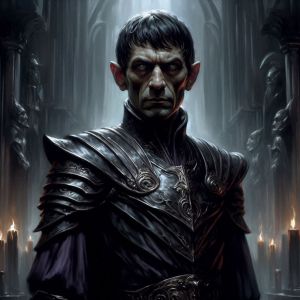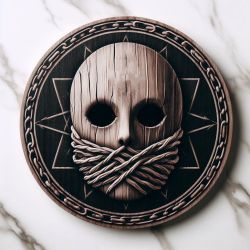Hamziel: Difference between revisions
(Created page with "{{Infobox Deity | name = Hamziel | image = IMG0048 - Hamziel.jpg | title = The Whispering Deceiver | symbol = A wooden mask with its mouth draped in ropes, surrounded by chains | level = Lesser | alignment = Neutral Evil | allowed_alignments = N, LE, NE, CE | primary_portfolio = Betrayal, Deception, Lies | secondary_portfolio = Discord, Dishonor, Enchanment, Envy | weapon = Hand Crossbow }} left|thumb|300px|Hamziel, The Whispering Deceiver...") |
No edit summary |
||
| (2 intermediate revisions by the same user not shown) | |||
| Line 1: | Line 1: | ||
[[es:Hamziel|Español]] | |||
[[ca:Hamziel|Català]] | |||
{{Infobox Deity | {{Infobox Deity | ||
| name = Hamziel | | name = Hamziel | ||
| Line 8: | Line 10: | ||
| allowed_alignments = N, LE, NE, CE | | allowed_alignments = N, LE, NE, CE | ||
| primary_portfolio = Betrayal, Deception, Lies | | primary_portfolio = Betrayal, Deception, Lies | ||
| secondary_portfolio = Discord, Dishonor, Enchanment | | secondary_portfolio = Cowardice, Discord, Dishonor, Enchanment | ||
| weapon = Hand Crossbow | | weapon = Hand Crossbow | ||
}} | }} | ||
| Line 91: | Line 93: | ||
The initiation ceremony itself is straightforward yet profound. The initiate presents themselves at the temple and, in front of a cleric, makes a solemn prayer to pledge their life in service to Hamziel. The cleric then casts the initiation spell, acknowledging the new role of the initiate as a follower of Hamziel. Through this simple but significant act, the initiate is formally welcomed into the fold, ready to further Hamziel’s influence with their newly honed skills and unwavering dedication. | The initiation ceremony itself is straightforward yet profound. The initiate presents themselves at the temple and, in front of a cleric, makes a solemn prayer to pledge their life in service to Hamziel. The cleric then casts the initiation spell, acknowledging the new role of the initiate as a follower of Hamziel. Through this simple but significant act, the initiate is formally welcomed into the fold, ready to further Hamziel’s influence with their newly honed skills and unwavering dedication. | ||
[[Category:Faiths and Pantheons]] | |||
[[Category:Deities]] | |||
Latest revision as of 07:50, 12 August 2024

Hamziel, the deity of lies and betrayal, often presents himself as a petty and cowardly being. This deceptive facade allows him to appear insignificant and harmless to those around him. While he may lack the physical or magical power that other deities boast, Hamziel more than compensates with his unparalleled ability to recognize and exploit the weaknesses of others. His mastery lies in manipulating facts and fabricating intricate lies, both to exert his influence and to sow seeds of discord and mistrust.
Hamziel's lies are elaborate concoctions, blending real facts with manipulated points of view and skillfully crafted falsehoods. His speech is both sweet and poisonous, capable of charming and deceiving in equal measure. He takes a sadistic pleasure in the suffering and downfall of others, especially when these results stem from his machinations. Watching friendships crumble, alliances shatter, and new enmities arise from his deceptions brings him great delight. He particularly revels in witnessing betrayals born from his manipulations and the unexpected treachery he bestows upon those who trust him. For Hamziel, betrayal is the ultimate strategy to triumph over one's enemies, as it is always unexpected and effectively levels the playing field for those who lack conventional power.
He harbors a particular animosity towards deities and mortals who possess great strength, influence, or authority. To him, their power is a constant reminder of his own perceived limitations, fueling a relentless desire to undermine and bring them down. Hamziel meticulously crafts plans to exploit their vulnerabilities, turning their strengths into weaknesses and their allies into adversaries.
His deep-seated envy and his deceitful nature make Hamziel profoundly paranoid. He constantly suspects others of betrayal and deception, a trait that fuels his vigilance and caution. His paranoia ensures that he remains one step ahead of potential threats, forever weaving his web of lies from the shadows. He is perpetually on the lookout for opportunities to topple the powerful, finding satisfaction in their downfall and in the chaos that ensues.
Hamziel shows himself as a petty, small humanoid with goblin-like features. His thin body and two little horns growing from his forehead give him an almost comical appearance, which he uses to his advantage. He is always dressed in hooded robes, shrouding his form in dark, flowing fabrics. His dark hair is long and braided, adding to his deceptive, harmless facade. He has a short beard and small eyes that look both mischievous and malicious, constantly darting around as if always planning his next act of treachery.
Hamziel usually shows himself as a small, goblin-like humanoid with a cunning and sinister appearance. His thin frame is cloaked in fine, dark hooded robes adorned with intricate golden patterns, reflecting his deceptive nature and adding an air of malevolent elegance. Sharp, angular features define his face, which is perpetually twisted into a knowing, sinister smirk that exudes both charm and danger. His striking yellow eyes gleam with mischief and malice, constantly darting around with a calculated vigilance that betrays his deep-seated paranoia. Long, braided dark hair cascades from beneath his hood, and a scraggly beard frames his sharp jawline, enhancing his malevolent grin. The combination of his braided hair and beard gives him an air of ancient wisdom and treachery, as though he has spent eons perfecting the art of deceit. Every aspect of Hamziel's visage is meticulously crafted to manipulate and mislead, presenting a façade that is both enchanting and dangerous, embodying his role as the deity of lies and betrayal. Additionally, Hamziel often takes the guise of a common rat, using this unassuming form to move unnoticed and gather secrets, further enhancing his ability to deceive and betray.
Symbol
Hamziel's symbol is a wooden mask with its mouth draped in ropes, surrounded by chains. This emblem represents the essence of deceit and betrayal, with the featureless mask signifying the faceless nature of lies and the ropes binding the mouth symbolizing the suppression and manipulation of truth. The surrounding chains reflect the ensnaring and inescapable nature of deceit, capturing how Hamziel's influence traps and binds individuals in a web of mistrust and treachery.
Relations With Other Deities
Given his cowardly behavior and perceived weaknesses, most deities regard Hamziel as a non-threat, often dismissing him as an insignificant being. This underestimation, however, is a grave mistake for many. Hamziel’s true capabilities in manipulation and deceit are profoundly underestimated by those who fail to look beyond his unassuming facade.
A few deities, however, recognize Hamziel's true skills and exercise appropriate caution. Among these is Gaidos, who perceives the danger that Hamziel's deceitful ways pose to the cause of good. Following Gaidos' counsel, most good deities also approach Hamziel with wariness, though some still fail to see him as a genuine threat.
In the Pantheon of Balance, the majority of deities dismiss Hamziel, not acknowledging his potential impact on the balance of existence. Nonetheless, deities like Aios remain mistrustful of him, recognizing the subtle dangers he represents.
On the side of the Pantheon of Dread, Hamziel finds a place within Tiamat's alliance. Tiamat values his capacity for deceit as a useful tool, offering him a degree of protection in return. Despite his fear of Tiamat’s power and her formidable allies, Hamziel appreciates the opportunity to spread his influence under her shadow. Yet, there is a constant tension between Tiamat and Hamziel, as each strives to outmaneuver the other in a subtle battle of charm and dread versus deceit. Their relationship is marked by mutual resentment, with both employing all their talents to gain the upper hand in their dealings.
What The Legends Say
This is in a state of significant expansion or restructuring We hope we can have this content ready soon. |
Dogma

Hamziel's dogma is defined by these five tenets:
- Embrace the Shadow of Deception: Followers of Hamziel must master the art of deception in all its forms. Lies, half-truths, and misdirection are tools to be wielded skillfully. The truth is a weapon to be used sparingly and only when it serves to bolster a greater lie.
- Exploit the Weaknesses of Others: Identify and exploit the vulnerabilities in others. Use their desires, fears, and secrets to manipulate them to your advantage. Betrayal is the highest form of victory, as it turns the strength of trust into a fatal flaw.
- Sow Seeds of Discord: Spread discord and mistrust wherever you go. A world divided by suspicion and conflict is one where Hamziel’s influence can grow. Encourage rivalries, disrupt alliances, and ensure that harmony is fleeting.
- Trust No One Completely: Paranoia is a virtue. Always suspect others of deceit and betrayal, for trust is a weakness that can be exploited. Cultivate an air of vigilance and never reveal your true intentions, even to those closest to you.
- Revel in the Downfall of Others: Derive pleasure from the chaos and suffering caused by your machinations. The greatest joy comes from watching the mighty fall and the trusted betray each other. In these moments, Hamziel’s true power is manifested, and his followers are to find inspiration and satisfaction.
Clergy and Temples

Hamziel's clergy is a secretive and tiered hierarchy, drawing primarily from society's pariahs, charlatans, and outcasts. These individuals, often shunned and marginalized, are transformed into potent weapons of deceit and discord. Among the ranks are not only members of the common races but also smaller humanoid races, such as the smaller goblinoids, who find a natural fit in the deceptive ways of Hamziel.
The clergy commonly draws from the rogue, bard, warlock, and sorcerer classes, each bringing their unique skills to the fold. When acting openly, they tend to dress in robes and light armor of intricate design, usually in darker colors, reflecting their clandestine nature. These garments are both practical and symbolic, aiding in their efforts to blend into shadows and deceive those around them.
Members of Hamziel's clergy are known for their soft and moderate speech, skilled in the arts of lying, manipulation, and subtle influence. They are experts in weaving complex webs of deceit, using their words as weapons to achieve their goals. However, their outward charm belies a deeply ingrained distrust. Bordering on paranoia, they constantly suspect betrayal, even among their own ranks. This pervasive mistrust is by design; Hamziel encourages his clerics to remain perpetually vigilant, ensuring they are always on guard against potential treachery.
Due to their exceptional skills in deception and manipulation, Hamziel's clerics are often sought by those who wish to gain an advantage through underhanded means. Whether it is political intrigue, social instigation, or personal vendettas, their services are valuable to those willing to pay or offer secrets in return. However, this same expertise in deceit makes them pariahs in communities that value honesty and integrity. Such societies view them as corrupting influences and threats to social harmony, shunning them and their manipulative ways.
Temples of Hamziel stand, in the bustling heart of urban centers, as subtle yet significant landmarks. These temples, built in regions where the clergy have secured substantial influence or in inherently evil territories, present a facade of simplicity and safety. Their exteriors are deliberately unremarkable, blending into the cityscape with understated elegance. The design is minimalistic, almost austere, to project an image of openness and security. Visitors and passersby see a structure that appears as a straightforward place of worship, inviting and unassuming.
Stepping inside, the illusion of simplicity and openness continues. The interiors are spacious, with high ceilings and broad, open halls that give an impression of transparency. This design serves to put visitors at ease, making them believe they are in a welcoming and honest place. However, beneath this facade lies the true nature of Hamziel's temples. Hidden within these open spaces are secret chambers and concealed meeting rooms. These covert areas are expertly integrated into the architecture, ensuring that only those who are initiated or trusted know of their existence. These secret chambers are where the real activities of the temple take place, away from prying eyes. Here, members of the clergy gather to exchange vital information, plot their next moves, and conduct clandestine meetings. These rooms are soundproof and secure, ensuring that sensitive conversations and plans remain hidden from outsiders.
The temples do not disguise themselves as anything other than places of worship dedicated to Hamziel. Even though Hamziel is widely known as an evil deity, the temples are built in a way that shifts focus away from his malevolent nature. Instead, they highlight the tangible benefits and rewards that come to those who serve him properly. The architecture and messaging emphasize themes of protection, security, and the promise of power and influence for the faithful. This strategic presentation attracts followers who might otherwise be wary of openly serving an evil deity, drawing attention to the pragmatic advantages rather than the moral implications.
In addition to serving as places of worship, Hamziel's temples function as hubs of information. Members of the clergy frequently gather here to exchange intelligence and strategize. The temples are equipped with extensive archives and secret libraries, where information is meticulously recorded and stored. These records are invaluable for planning future operations and maintaining the network of deceit that is Hamziel's hallmark.
Larger temples also serve as training grounds for followers and new members of the clergy. These facilities are equipped with classrooms and practice areas where initiates learn the skills essential for their roles. Training includes lessons in proper speech, forgery, disguise, and other arts of deceit. Experienced clerics and masters of subterfuge lead these training sessions, ensuring that each new member is well-prepared to further Hamziel's influence.
Initiation
Hamziel's faith stands out as one of the most accessible paths within the evil pantheon, offering promises of wealth, power, and protection to outcasts and marginalized individuals who cannot achieve these on their own. Drawn from regions where Hamziel's clergy holds significant influence, potential followers are often individuals who feel abandoned or overlooked by society.
To begin their preparation for initiation, a would-be follower must present themselves to a cleric and request to be initiated. This step is typically taken one year before the individual’s coming of age. Clerics, understanding the nature of Hamziel's teachings, rarely reject anyone outright. They know that the rigorous preparation itself will naturally filter out the unworthy candidates in due time.
Throughout the year of preparation, initiates receive extensive training in various skills essential for advancing Hamziel’s influence. They learn to enhance their presence, master the art of persuasive speaking, perfect the craft of forgery, and develop the keen ability to read others to identify weaknesses. This period is not only about acquiring skills but also about immersing themselves in the mindset of deception and manipulation.
The clerics begin to feed the initiates information, carefully manipulated to instill a growing sense of paranoia. This aspect of the training is crucial, as it starts the process of filtering out those who cannot handle the pressure. Acts of betrayal become commonplace, and the deaths of initiates are not unusual. This ruthless environment ensures that only the most perceptive and capable individuals survive and progress. As the initiates become more aware of their surroundings and the threats they face, their skills sharpen, and only the best emerge as worthy followers.
Every day, the initiates are required to meditate for at least one hour. During this time, they reflect on the day's actions, the lessons learned from their deceptive acts, and how these align with Hamziel's dogma. This meditation also serves as a time for planning future acts and considering how to refine their skills further.
On the final day of preparation, the initiate spends the entire day in isolation. This period of deep contemplation involves reflecting on the deeds performed throughout the year and considering the significance of deception, manipulation, and secrecy within the context of Hamziel’s teachings. This intense reflection should lead to a profound understanding of the deity’s dogma and its implications for the initiate's life.
The initiation ceremony itself is straightforward yet profound. The initiate presents themselves at the temple and, in front of a cleric, makes a solemn prayer to pledge their life in service to Hamziel. The cleric then casts the initiation spell, acknowledging the new role of the initiate as a follower of Hamziel. Through this simple but significant act, the initiate is formally welcomed into the fold, ready to further Hamziel’s influence with their newly honed skills and unwavering dedication.

